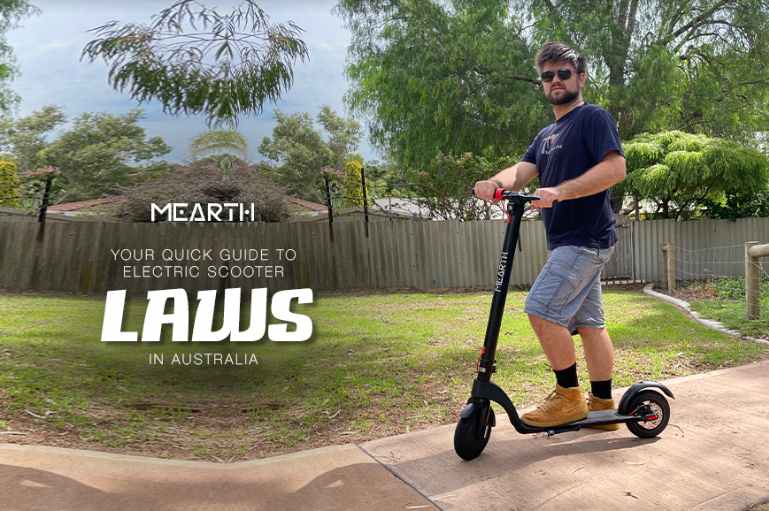Your Quick Guide to Electric Scooter Laws in Australia

As a prospective buyer or new owner of your chosen electric scooter, it pays to ask these all-important questions: What are the laws governing buying, and riding, electric scooters? Are there any restrictions, or none on the road, regarding access to pathways or public and main roads, etc? Are there speed limits? Ask away!
A responsible retailer giving you pointers on the electric scooter you’re considering getting is duty-bound to give you the right and correct information. Ignorance of the law does not exempt anyone. Mearth, the premier manufacturer of its high-quality, top performing electric scooter brand has been commended for not having been given reports of any violation whatsoever because the riders and owners of those electric scooters are given proper information on Australia’s present laws and rules on e-scooter riding, guidance, and tips to help keep them safe on the road.
By knowing your rights and responsibilities, along with the consequences in case the laws about electric scooters are violated; you, as the rider-cum-owner, gain full awareness of the limitations; and restrictions so you will be better informed on how to steer clear of mistakes and avoid penalties. Each of Australia’s states has its own set of laws and regulations and they can be helpful as to how you can use e-scooter in that part or region. Forewarned is forearmed. Here’s a summarized list of the e-scooter laws by state:
1. The Electric Scooter Laws in Queensland:
The Electric Scooter Laws in Queensland give legal rights to ride an e-scooter on public roads and footpaths. But the law prohibits e-scooters along the bike lanes and in areas with a 50km/h speed limit. The standard speed limit in QLD is 25km/h. Riding around the south bank, the speed limit should be 10km/h. Riders should wear helmets. Children under 12 cannot ride, and riders up to 16 must be supervised by an adult. Riders must give way to pedestrians. Rule breakers will be subject to a fine.
2. Electric Scooter Laws in Victoria:
Electric Scooter Laws in Victoria allow 200w power output and a speed limit of 10km/h that can be used on public roads and footpaths. There are no specific laws presented on what requirements to follow but, the Victorian state government has set rules on certain kinds of scooters, specifically, if the source of power for the motorized scooter is a petrol motor, or if it has an electric motor with a maximum power greater than 200 watts, or a maximum speed greater than 10 km/h. Non-compliance renders it illegal to use an e-scooter on Australian roads or any road-related areas; including footpaths, shared paths, and public areas. Therefore, there will be a fine for using an illegal device.
3. Electric Scooter Laws in ACT:
Electric Scooter Laws in ACT allows e-scooters, skateboards; and any similar device to be legally driven on shared paths and footpaths, effective December 20, 2019. This is according to the ACT Government. Further, the Minister for Justice, Consumer Affairs, and Road Safety Shane Rattenbury said that this law will enable the ACT to move towards its target sustainable power source. Laws on the use of electric scooters include — a maximum speed of 15 km/h on footpaths; up to 25 km/h in all other permitted locations; slowing down to 10 km/h when going across a crossing; giving way to pedestrians, and mandatory wearing of a helmet.
4. Electric Scooter Laws in NSW:
Electric Scooter Laws in NSW do not allow riding an e-scooter on public roads and footpaths. However, the law permits riding it on private grounds. As a matter of update, excessive fines with electric scooters are now considered illegal. Last April 2022, NSW started the trial for electric scooters in select councils with a view to making them legal this year, as it sought to improve access to active transport options. The end date for e-scooter trials is extended to spring 2022 (November – December 2022).
5. Electric Scooter Laws in SA:
Electric Scooter Laws in SA do not allow riding an e-scooter on public roads and footpaths. The law, however, allows riding an e-scooter on private grounds. The South Australia state government will update its transport legislation to allow e-scooters on public grounds — soon. Take note, if one is caught riding an e-scooter not approved for this trial, there will be a fine for driving an unregistered and uninsured motor vehicle.
6. Electric Scooter Laws in WA:
Electric Scooter Laws in WA give riders the directive to follow the rules as to where and when they can ride. In addition, the law in this state does not permit the use of shared paths and footpaths for e-scooters. Riders are to keep on the left side and give way to pedestrians. E-scooter riders are required to wear a helmet.
The Road Traffic Code 2000 also states that motorized scooters are not allowed: on roads with a speed limit exceeding 50km/h; to use a road only with a dividing line or median strip; to use a one-way road with more than one marked lane; and not allowed to ride during the night, especially in dark areas.
7. Electric Scooter Laws in NT:
Electric Scooter Laws in NT allow e-scooters that are limited to less than 200w in power output, with capable speeds below 10km/h. They are also permitted for use on public roads and footpaths. Scooters exceeding this power and speed require registration.
Motorized e-scooters however, are not designed or manufactured to comply with registration requirements and national safety standards for road vehicles, such as Australian Design Rules (ADRs). Given this, they cannot be granted registration for on-road use and may not be ridden on public roads or places open to the public (including footpaths, bike paths, car parks, etc.
The Northern Territory state government is being sought to update their transport legislation to allow faster and more powerful scooters later this year and to follow suit with that of Queensland.
8. E-Scooter Laws in TAS states:
E-Scooter Laws in TAS states that the allowable power limit is less than 200w for it to set foot on public roads and footpaths. Scooters exceeding this power and speed will require registration.
In ACT, NSW, TAS, and VIC however, riders must complete training and be able to meet specific requirements before they are allowed to take the micro-mobility devices for a spin outside.
Now you know e-scooters are still in a testing phase for most states here in Australia. The good news is that they have gained a significant footing in the past few years. With the convenience of e-scooters and electric bikes, it’s only a matter of time until we see more and more people using these vehicles. And the way things are shaping, the future for electric scooters certainly looks promising and bright.

